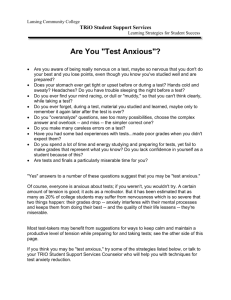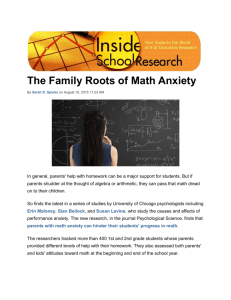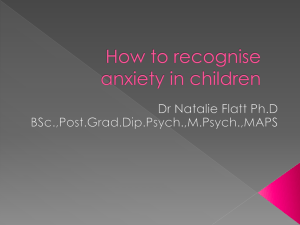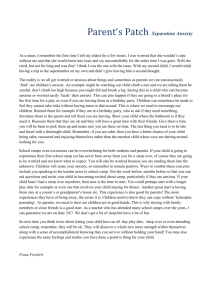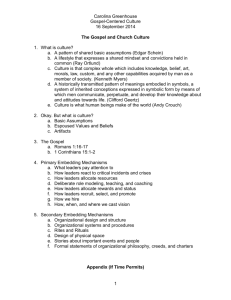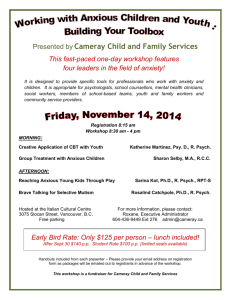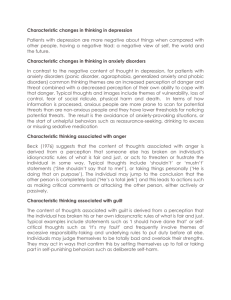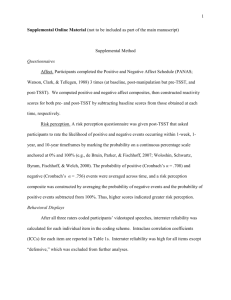Anxiety
advertisement
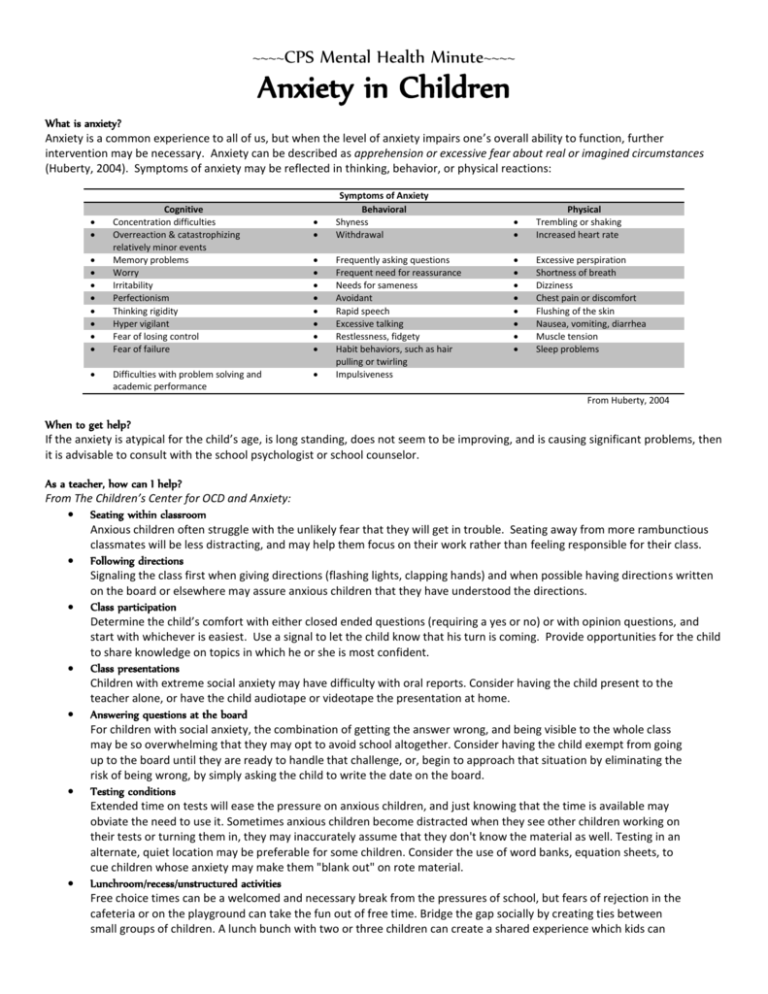
~~~~CPS Mental Health Minute~~~~ Anxiety in Children What is anxiety? Anxiety is a common experience to all of us, but when the level of anxiety impairs one’s overall ability to function, further intervention may be necessary. Anxiety can be described as apprehension or excessive fear about real or imagined circumstances (Huberty, 2004). Symptoms of anxiety may be reflected in thinking, behavior, or physical reactions: Cognitive Concentration difficulties Overreaction & catastrophizing relatively minor events Memory problems Worry Irritability Perfectionism Thinking rigidity Hyper vigilant Fear of losing control Fear of failure Difficulties with problem solving and academic performance Symptoms of Anxiety Behavioral Shyness Withdrawal Frequently asking questions Frequent need for reassurance Needs for sameness Avoidant Rapid speech Excessive talking Restlessness, fidgety Habit behaviors, such as hair pulling or twirling Impulsiveness Physical Trembling or shaking Increased heart rate Excessive perspiration Shortness of breath Dizziness Chest pain or discomfort Flushing of the skin Nausea, vomiting, diarrhea Muscle tension Sleep problems From Huberty, 2004 When to get help? If the anxiety is atypical for the child’s age, is long standing, does not seem to be improving, and is causing significant problems, then it is advisable to consult with the school psychologist or school counselor. As a teacher, how can I help? From The Children’s Center for OCD and Anxiety: Seating within classroom Anxious children often struggle with the unlikely fear that they will get in trouble. Seating away from more rambunctious classmates will be less distracting, and may help them focus on their work rather than feeling responsible for their class. Following directions Signaling the class first when giving directions (flashing lights, clapping hands) and when possible having directions written on the board or elsewhere may assure anxious children that they have understood the directions. Class participation Determine the child’s comfort with either closed ended questions (requiring a yes or no) or with opinion questions, and start with whichever is easiest. Use a signal to let the child know that his turn is coming. Provide opportunities for the child to share knowledge on topics in which he or she is most confident. Class presentations Children with extreme social anxiety may have difficulty with oral reports. Consider having the child present to the teacher alone, or have the child audiotape or videotape the presentation at home. Answering questions at the board For children with social anxiety, the combination of getting the answer wrong, and being visible to the whole class may be so overwhelming that they may opt to avoid school altogether. Consider having the child exempt from going up to the board until they are ready to handle that challenge, or, begin to approach that situation by eliminating the risk of being wrong, by simply asking the child to write the date on the board. Testing conditions Extended time on tests will ease the pressure on anxious children, and just knowing that the time is available may obviate the need to use it. Sometimes anxious children become distracted when they see other children working on their tests or turning them in, they may inaccurately assume that they don't know the material as well. Testing in an alternate, quiet location may be preferable for some children. Consider the use of word banks, equation sheets, to cue children whose anxiety may make them "blank out" on rote material. Lunchroom/recess/unstructured activities Free choice times can be a welcomed and necessary break from the pressures of school, but fears of rejection in the cafeteria or on the playground can take the fun out of free time. Bridge the gap socially by creating ties between small groups of children. A lunch bunch with two or three children can create a shared experience which kids can then draw on later. When working in pairs or small groups, don't always have children choose the groupings themselves, alternate this with a "counting off" technique or drawing straws to allow variability in the groupings. Safe person Having one person at school who understands the child's worries and anxieties can make the difference between a child attending school and staying home. A guidance counselor, principal, nurse, or teacher can be identified as a point person for the child to check in with briefly (5-10 minutes) to help dispel worry thoughts, take deep breaths and return to class. Cool down pass Pressures build for anxious children; being able to leave the situation briefly to get a drink of water or wash their face can allow them to clear their heads and return to class on a less anxious track. Since anxious children may be hesitant to ask for this and risk being the center of attention, use an orange card which the child simply places on his desk, or the teacher’s desk, which signals they are out on break. Change in routine/substitute teachers Because anxious children try very hard to please and predict what is required in a situation, changes of any sort may be experienced as very stressful. When possible, send a note home the day before to alert the child/family to a change in routine. This will allow the child to process the change in his or her comfort zone and will make the transitions go more smoothly the next day. Homework expectations If children are spending inordinate amounts of time on homework because of OCD redoing, rechecking, rereading, or simply worrying that the assignment wasn't done thoroughly enough, the teacher can set a reasonable amount of time for homework and then reduce the homework load to fit into that time frame. Teachers can also provide time estimates for each assignment (this could be helpful to the entire class), so that the anxious child can attempt to stay within 10% of the estimated time. Eliminate repetition by having the child do every other math question, reduce reading and writing assignments, consider books on tape if a child is unable to read without repetition, for a child with writing difficulties, consider having a parent, teacher, or another student "scribe" for the child while he or she dictates the answers. References Huberty, T. J. (2004). Anxiety and Anxiety Disorders in Children: Information for Parents. In Helping Children at Home and School II: Handouts for Families and Educators (pp. S5-1-S5-4). Bethesda, MD: National Association of School Psychologists. Sample Accommodations for Anxious Kids. (n.d.). Retrieved January 30, 2012, from http://www.worrywisekids.org/schools/sample_accomodations.html Websites Anxiety Disorders Association of America www.adaa.org
